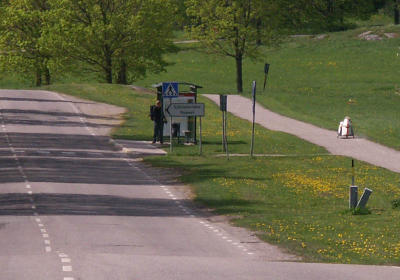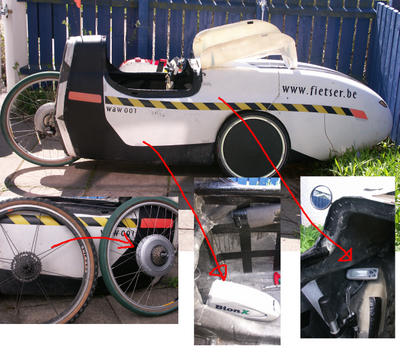First practical experience -- 300 km report
As it turns out, riding into town and back, a 50km roundtrip, is no problem at all. The first roundtrip, the battery indicator showed that about a third capacity was left, so that should result in approximate range of 70-80 km. Second ride was similar. The third charge I managed to empty completely in exactly 80km. And this with the assist level on level 3 (100% assist) and a few times on 4 on the steepest bits. That day I went on an interview so I took it easy not to sweat too much using the assist quite a lot; also I and Peter did the hill up to his place several times. Once empty, the Waw still remains a very capable velomobile, the main difference being that it is about 8kg heavier. I hardly notice the BionX is there on an even course. And so it should be as I want it to behave as before when riding above 25km/h!! Very different to the handicap or almost complete immobilisation with respectively the Aerorider and the Twike when the batteries run out. No, the BionX does not make you ride an electrical vehicle; it is still very much a HPV.
Charge 4 was more energetic riding form my part into town, going to HPV Sweden’s national member meeting. It resulted in 25% charge left after 80km, so a range of 100km is possible (I did ride a bit in regenerator mode during our parade through town, but that was very little and probably offset by red-light sprints on assist - more on such later).
In all above instances, the brake regeneration was used as much as possible. Works very well and makes me ride at more appropriate speeds in some traffic conditions because i feel that I am not completely LOSING my hard-worked-for speed when I slow down precautionary.
Interpolating from our test with the MTB on almost flat surroundings which gave a range of about 35km on level 3, these ranges are very promising. Or should I say, Impressive! At second thought, there are several obvious reasons why the velomobile has a much better range. First, regular riding speed is higher, so much less likely to end up under the 25km/h barrier using the engine every time one slows down a bit (if one rides above 25km/h at all with a bicycle!!). Second, the kinetic energy of a velomobile is usually much higher, so the regenerative braking should be much more effective. In the same conditions as the first test in Belgium, the BionX would probably have a range of, perhaps(?), 300km if I am riding... which brings us to...
To measure is to Know (M5's dada, translated)
All this are the results of practical use. The question is of course, what does it mean? It is not so easy to quantify the conditions of riding here just north of Stockholm. For instance, what are the elevation differences and slopes in the different routes? Not a clue, really. On a ride two new friends, Mikael had a GPS with him which also recorded the total climbing done. Unfortunately, this measurement was related to air pressure and the very unstable weather resulted in a total climbing of 2,7km on our 25km trip. NOT! Should be a few hundred meters I suspect. Subjectively, it is definitely not as flat as Flevoland, nor as flat as the Flemish lowlands. It is more like the surroundings of Brussels. One is never sure if the road is really flat. I have this piece on my route that feels uphill in both directions. Haven't figured out why.... :-D
So the surroundings are hilly, the kind you really notice when cycling, but don't pay special attention to when driving a car...
My speed on the steeper climbs on my route before BionX were about 10-15km/h depending on my mood. With BionX at 100% assist (level3), they are 18-23 km/h. With the option of doing the latter more relaxed by putting it into 200% assist (level 4). So, definitely faster, but we are not talking about 120km/h uphill on a steep highway. We are still talking cycling speeds, not motorised speeds. I weigh about 80kg and pedal somewhere between 100 and 250W on my commutes, I guess. Peter is a whole lot less younger than me (he could almost be my granddad), and probably has less than half the power at his own disposal. He probably needs some wider gearing just to be able to pedal hard enough so that the BionX "unleashes" its full 250W* on 200% assist level... (again, you have to pedal real power to get any help, the engine measures your effort and then "seconds" that). Peter will write on this blog about his experiences later on.
After a few more rides, I intend to write on how the BionX influences my riding style and the "cycling feeling". 100% subjective impressions.... More ideas after that too, so there is more to come! Circumstances permitting...
*My kitchenmixer has similar power...





